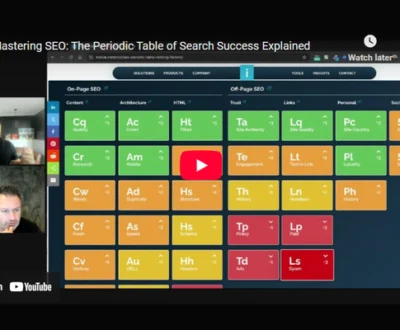I use data tables to present complex information clearly, which makes pages easier for both users and search engines to understand. By organizing data with concise headers and maintaining strong visual hierarchy, I boost readability and engagement. I also optimize tables for mobile by simplifying layouts and ensuring accessibility with proper HTML tags. Adding structured data helps search engines create rich snippets, improving visibility. These steps enhance on-page SEO effectively, and you can discover more techniques to strengthen your site’s performance.
Key Takeaways
- Organize complex data clearly with concise headers and visual hierarchy to improve readability and align with SEO best practices.
- Use semantic HTML tags and ARIA labels to enhance accessibility and ensure search engines correctly interpret table content.
- Optimize tables for mobile by simplifying columns, using responsive layouts, and locking key columns for easier navigation.
- Implement structured data and schema markup to help search engines understand table content and enable rich snippets.
- Avoid overcrowding tables and prioritize essential information to increase user engagement and improve on-page SEO metrics.
SEO Advantages of Incorporating Data Tables
Although many SEO techniques focus on keywords and backlinks, incorporating data tables can greatly enhance your on-page SEO.
Data tables improve data organization by presenting complex information clearly, which makes it easier for both users and search engines to understand your content. This structured approach not only boosts readability but also aligns with Google’s E-E-A-T guidelines, helping demonstrate your content authority.
When you use tables correctly, search engines can index your pages more accurately and quickly, reducing the risk of misindexing. Additionally, well-organized tables increase your chances of being featured in Google’s snippets, which can improve your click-through rate. Gathering a variety of data points to include in tables ensures a more comprehensive representation.
Beyond search engines, tables enhance user experience by simplifying data presentation, encouraging longer engagement and better interaction with your site.
Optimizing Data Tables for Mobile and Accessibility
Incorporating data tables into your SEO strategy improves content clarity and authority, but making those tables work well on mobile devices and for all users is just as important.
To boost mobile usability, I recommend transforming table rows into card-like layouts or using tabs and dropdowns to reduce clutter on small screens. Locking the first column during horizontal scrolling keeps context clear, while floating filters and sticky headers enhance navigation without overwhelming users. However, it is crucial to reduce the number of columns and data per row to enhance readability on mobile devices, as limited screen space can make traditional tables problematic.
For accessibility features, using semantic HTML tags like <table>, <thead>, <tbody>, and <th> helps screen readers interpret the data accurately. Keyboard navigation support and descriptive ARIA labels improve usability for those relying on assistive technologies.
Avoid relying solely on horizontal scrollbars, as they can be hard to manage with accessibility tools. By combining responsive design with thoughtful accessibility features, you guarantee your data tables remain useful and user-friendly across all devices, ultimately supporting better SEO outcomes.
Leveraging Structured Data and Schema Markup for Rich Snippets
When you add structured data and schema markup to your webpages, you help search engines better understand your content, which can lead to richer search result displays.
Schema integration enhances the clarity of your data tables by providing explicit context, making it easier for search engines to generate rich snippets. These enhanced listings improve your page’s visibility and can boost click-through rates.
Why Schema Markup Matters for Your Data Tables:
- Clarifies content meaning, reducing ambiguity for search engines.
- Enables rich snippets, such as ratings or FAQs, directly in search results.
- Supports multiple schema types, including product, review, and event schemas.
- Widely supported by major search engines like Google and Bing.
Best Practices for Designing User-Friendly Data Tables
Designing user-friendly data tables requires careful attention to both structure and usability to guarantee that information is easy to find and understand.
First, prioritize table organization by placing essential columns at the beginning and grouping related data together to help users compare information quickly. Clear, concise column headers improve readability, while alignment matters—text aligns left, and numbers align right for straightforward comparison.
Establishing a strong visual hierarchy is equally important; use bold fonts and shading for headers to separate them from content, and apply zebra striping to distinguish rows visually. Consistent spacing and high contrast enhance clarity, reducing visual noise and making scanning easier.
Additionally, avoid overcrowding tables with unnecessary columns or repeated titles, as this complicates comprehension. By focusing on these best practices, you create data tables that not only look organized but also improve user experience, ensuring visitors can efficiently access and understand the presented information.
Using Data Tables to Boost User Engagement and SEO Metrics
Data tables play an essential role in boosting both user engagement and SEO metrics by organizing information in a clear, accessible way. When users find data easy to navigate, they tend to stay longer, increasing session duration and engagement rates.
From my experience, integrating well-structured tables supports metrics analysis by presenting complex data simply.
Four ways data tables enhance user engagement and SEO:
- Improved readability – Users can absorb key points quickly without wading through paragraphs of text.
- Structured content for indexing – Search engines can interpret and index data effectively.
- Highlighting performance metrics – Useful for dashboards and KPI tracking.
- Cross-device consistency – Ensures users on mobile or desktop get the same value.
Real Estate Table Example: Property Features & Pricing
| Property Name | Location | Lot Size (sqm) | Price (USD) | Availability |
|---|---|---|---|---|
| Monterrazas Prime | Cebu City, PH | 350 | $280,000 | Available |
| The Rise Residences | Makati City, PH | 55 (condo) | $120,000 | Limited Units |
| The Peaks Central | Cebu City, PH | 500 | $400,000 | Sold Out |
Automotive Table Example: Model Comparison
| Model Name | Engine Type | Horsepower | Fuel Efficiency (km/l) | Price (USD) |
|---|---|---|---|---|
| Ford Ranger XLT | Diesel | 210 | 12 | $35,000 |
| Ford Territory | Hybrid | 187 | 18 | $28,000 |
| Ford Everest LTD | Diesel | 210 | 11 | $45,000 |
Authoritative References
- Google Developers. (2023). Accessible tables.
- W3C Web Accessibility Initiative. (2022). Table accessibility guidelines.
- Schema.org. (2023). Table markup schema.
- Nielsen Norman Group. (2021). Designing effective data tables.
- Google Search Central. (2023). Structured data guidelines.
Frequently Asked Questions
How Do Data Tables Impact Website Loading Speed?
Data tables can slow website performance if not optimized properly. Reducing data load and improving rendering speeds help enhance user experience.
Can Data Tables Be Used Effectively in Blog Posts?
Yes. Data tables make complex information easier to digest, increasing engagement and reader satisfaction.
What Software Tools Are Best for Creating SEO-Friendly Tables?
Google Sheets with SEO add-ons, Tableau, and Google Data Studio are effective for creating and embedding optimized tables.
How Often Should Data Tables Be Updated for SEO Purposes?
Every 3–6 months to keep content relevant and aligned with current search trends.
Are Interactive Tables More Beneficial Than Static Tables for SEO?
Interactive tables often keep visitors engaged longer, improving session metrics and encouraging deeper exploration.
Final Thoughts
Using data tables effectively can transform your SEO strategy in ways you might not expect. By optimizing for mobile, accessibility, and incorporating structured data, you set the stage for better rankings and richer search results. The design choices you make influence user engagement more than you realize. Small adjustments in table design, placement, and schema can lead to significant SEO gains.
Windee Tan is a seasoned SEO Specialist with over a decade of experience helping businesses grow their organic visibility through data-driven strategies. He specializes in technical SEO, content optimization, and local search, with deep knowledge of tools like GA4, GSC, SEMrush, and Screaming Frog. Windee is passionate about translating complex SEO insights into practical tactics that drive real-world results. When he's not auditing sites or crafting keyword strategies, he’s exploring the latest trends in AI, digital marketing, and productivity.
About this blog
We are a digital marketing company with a focus on helping our customers achieve great results across several key areas.
Request a free quote
We offer professional SEO services that help websites increase their organic search score drastically in order to compete for the highest rankings even when it comes to highly competitive keywords.
Subscribe to our newsletter!
More from our blog
See all postsRecent Posts
- Writing Clear Calls to Action That Boost On-Page SEO 21 August 2025
- Why Word Count Still Matters in On-Page SEO Today 20 August 2025
- Why Site Speed Is Critical for On-Page SEO Success 19 August 2025









